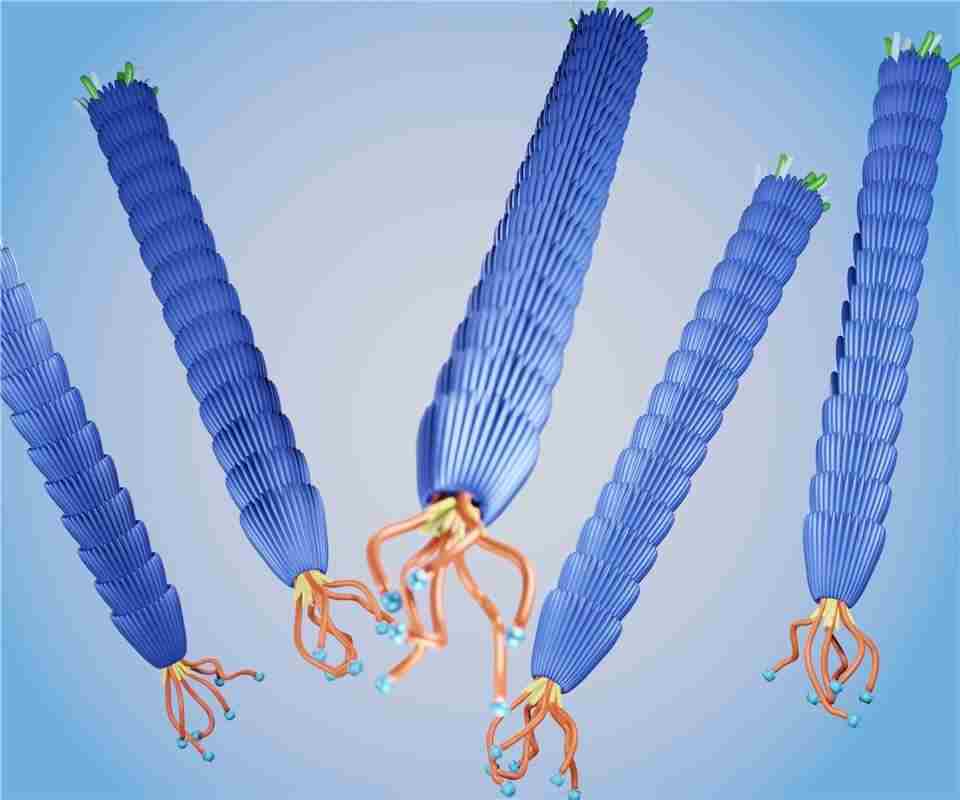Phage display technology involves inserting a segment of the exogenous gene into the appropriate position of the structural gene of the phage capsid protein. With a normal reading frame and without affecting the normal function of the capsid protein, the exogenous gene will be expressed along with the expression of the capsid protein, which will result in the presentation of the polypeptide or protein on the surface of the phage in the form of a fusion protein. Phage technology plays an important role in the field of antibody development and Creative Biolabs offers different phage display systems to facilitate customers' research and project development.
 Fig 1. Group of filamentous M13 phage virus
Fig 1. Group of filamentous M13 phage virus
To the best of our knowledge, the M13 phage is the only phage system that has been explored in toxinology. The M13 phage belongs to a group of filamentous phages collectively known as Ff phages and is a single-stranded circular DNA virus. Its genome is 6.4 kb and encodes 11 proteins, five of which are structural proteins, mainly including PVIII of coat proteins and PIII, PVI, PVII, and PIX of minor coat proteins. Among them, PIII and PVIII are two proteins commonly used in phage display, and the PIII and PVIII display system was constructed.
The T4 phage genomic DNA is a circularly arranged and double-stranded linear. The phage capsid has two non-essential capsid proteins, small outer capsid proteins, and highly antigenic outer capsid proteins. T4 phage surface display is the fusion of exogenous peptides or proteins with the C-terminus of the SOC site and the N-terminus of the HOC site, respectively, to be displayed on the surface of T4 phage. The T4 phage is able to realize the simultaneous display of the SOC site, and the number of copies to be displayed is also higher.
The T7 phage genome is a linear double-stranded DNA. It usually has two forms of coat protein, 10A (344 amino acid residues) and 10B (397 amino acid residues). Among them, the 10B coat protein region is present on the phage surface, so it is used to construct phage display systems. T7 phage display system can display peptides of 50 amino acids in high copy and peptides or proteins of 1200 amino acid residues in low (0.1-1/phage) or medium (5-15/phage) copy number. In view of the above features, T7 phage is widely used to screen proteins with different molecular weights and different affinities.
Lambda phage is a mild phage of the long-tailed phage family with an icosahedral head of 55 nm in diameter ending in an elongated tail filament. Its genome is a 48.5 kb linear double-stranded DNA molecule with sticky ends, i.e., a single-stranded extension of 12 nucleotides, and the linear genome can be looped immediately after infection. The head of the phage consists of D and V proteins, which can be constructed as a display system for D and V proteins. λ phage is assembled in the host cell, and it does not need to secrete foreign peptides or proteins to the bacterial cell membrane. It can display active large proteins (more than 100 kDa) and host cell toxic proteins, which are widely used.
Creative Biolabs has a wealth of knowledge and experience in phage display systems. We would be happy to discuss with you our knowledge and experience in phage display systems.
All listed services and products are For Research Use Only. Do Not use in any diagnostic or therapeutic applications.